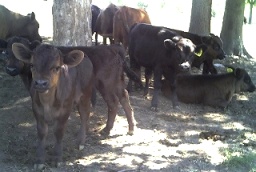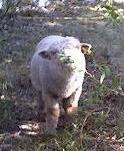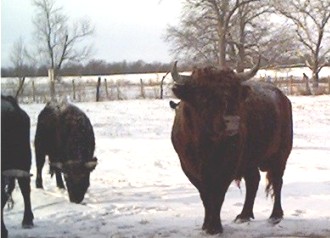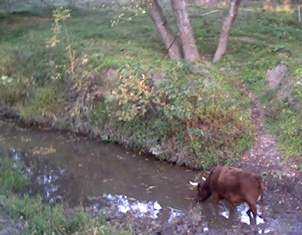|
Why Rare or Heritage Breeds?
 For me there is something interesting in owning and working with animals who are more “primitive,” whose characteristics come less from modern human selection for the biggest quantity of milk or meat, and more from broader and more “natural” selection criteria, For me there is something interesting in owning and working with animals who are more “primitive,” whose characteristics come less from modern human selection for the biggest quantity of milk or meat, and more from broader and more “natural” selection criteria,  either by humans—for such things as ease of care and handling—or by nature—for hardiness and adaptibility to environmental conditions. Humans who own and tend animals will always affect their reproduction and survival by the selections we make, so arguments on this issue abound. But I’m glad that some people have the preference for these heritage breeds, as for heirloom seeds of plants. either by humans—for such things as ease of care and handling—or by nature—for hardiness and adaptibility to environmental conditions. Humans who own and tend animals will always affect their reproduction and survival by the selections we make, so arguments on this issue abound. But I’m glad that some people have the preference for these heritage breeds, as for heirloom seeds of plants.
In Rare Breeds (Van Nostrand Reinhold, NY, 1980), Ralph Whitlock convincingly speaks of the value of preserving the heritage breeds and types.
“If it is true that breeds become rare through competition with better, it may be argued that the casualties should be allowed to slip into limbo. However, men, who are responsible for fashioning breeds, have made mistakes in the past and may do so again. The development of the very qualities which enable the newcomers to triumph may presently reveal hidden weaknesses. Breeds are all the more vulnerable today because of the prevalence of artificial insemination, whereby a popular cattle sire, for instance, may father scores of thousands of calves. Any flaws he may possess will make a proportional impact on the breed.
In the search for higher and more efficient production, better conversion rates, early maturity and other qualities on which modern livestock production is based, the risk is inherent of sacrificing hardihood, resistance to diseases, good mothering qualities and other intangible characteristics. Often realization of the danger does not come until quite late in the programme. Safety lies in the existence of a genetical reservoir of primitive material from which supplies may be drawn to correct errors.” (p.12)
He goes on to say that in general, “natural selection rather than human control shaped the development of the early types of livestock” and that their keeping by humans was often un-specialized, involving their abilties in draft and well as milk and meat production. They adapted to harsh conditions and survived. Even when domestic animals kept in other countries in similar conditions today are not now, by western standards,  the most “productive” types, “they are often triumphs of adaptation to difficult environmental conditions. The genes they have developed through centuries of struggle could be invaluable to breeders of the future.” (pp. 14-15) In modern times, keeping herds of “seedstock” of a type of domestic animal or seeds of older varieties of plants has proven to be valuable at various times when hybridizers’ and upgraders’ choices have affected the genepool in such a way that more “original” genetic lines were needed to get a breed or plant species back into a useful state. the most “productive” types, “they are often triumphs of adaptation to difficult environmental conditions. The genes they have developed through centuries of struggle could be invaluable to breeders of the future.” (pp. 14-15) In modern times, keeping herds of “seedstock” of a type of domestic animal or seeds of older varieties of plants has proven to be valuable at various times when hybridizers’ and upgraders’ choices have affected the genepool in such a way that more “original” genetic lines were needed to get a breed or plant species back into a useful state.
 The two kinds of breeding can be looked at as complementary rather than antagonistic, though some will prefer one type and others the other. For Dexter cattle, for example, breeders are of many different philosophies, abilities, and levels of interest, and there has historically been “room for all.” There is a certain amount of protection for the breed in that situation, even while the breed associations aim for a better dissemination of information about care and structural characteristics that promote health and so on. Current debates about the “purity” of various lines is of interest as relates to the integrity of human caretakers of the breed. But there is surely merit in breeding carefully and knowing the bloodlines of the stock. It behooves all breeders to have goals for their herds, and it surely falls to some to preserve particular genetics, as it falls to others to gather statistics on production traits and work toward their “improvement” goals. Where possible, it is especially worthy for breeders of a heritage breed to “take the long view” and avoid fads. The two kinds of breeding can be looked at as complementary rather than antagonistic, though some will prefer one type and others the other. For Dexter cattle, for example, breeders are of many different philosophies, abilities, and levels of interest, and there has historically been “room for all.” There is a certain amount of protection for the breed in that situation, even while the breed associations aim for a better dissemination of information about care and structural characteristics that promote health and so on. Current debates about the “purity” of various lines is of interest as relates to the integrity of human caretakers of the breed. But there is surely merit in breeding carefully and knowing the bloodlines of the stock. It behooves all breeders to have goals for their herds, and it surely falls to some to preserve particular genetics, as it falls to others to gather statistics on production traits and work toward their “improvement” goals. Where possible, it is especially worthy for breeders of a heritage breed to “take the long view” and avoid fads.
|